I’ve been collecting images of cloudbands for a number of years, but not as a concerted effort. If I come across something that looks interesting, I add it to the collection, but I don’t have many, less than 50, and I’ve scarcely looked at them, as most of my time is spent researching plants and text. A few days ago, I glanced through them and noticed one wasn’t a cloudband at all, but could easily be mistaken for one.
At first glance, this drawing from České republiky XXIII.C.124 (left) looks like there is some kind of liquid flowing from a bowl on the ground, and the undulating lines on the top left resemble a rudimentary cloudband of the kind more common to older manuscripts, before they took on their characteristic infurled shape:
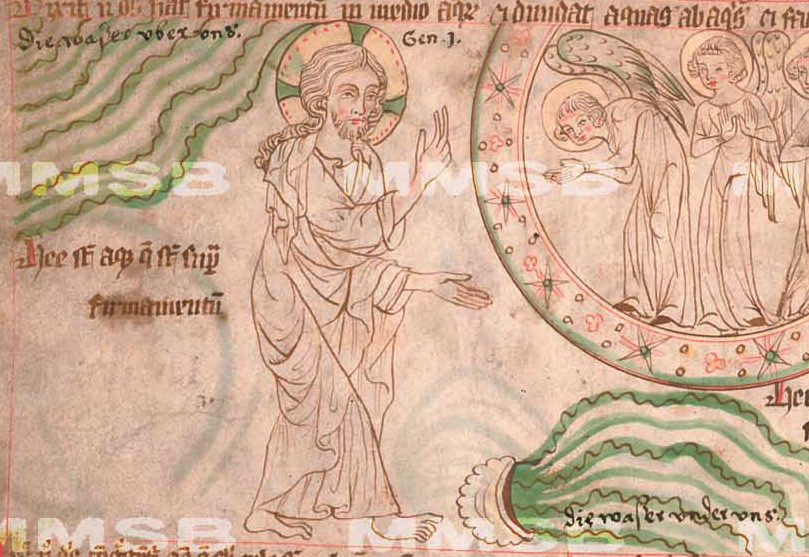 Many medieval manuscripts are fragments, some are unfinished, and some include very terse and difficult-to-understand labels that don’t reveal much about the illustrations, so it can be easy to misinterpret them—one often has to find several versions from the same tradition to understand the imagery.
Many medieval manuscripts are fragments, some are unfinished, and some include very terse and difficult-to-understand labels that don’t reveal much about the illustrations, so it can be easy to misinterpret them—one often has to find several versions from the same tradition to understand the imagery.
But this one is a little more clear, and upon reading the text, it turns out that God is parting the waters and that cloud-like shape in the sky isn’t a cloud at all. As the Bible says, “God made the expanse, and separated the waters which were below the expanse from the waters which were above the expanse…”
So both streams of undulating green are waters “below the expanse” and “above the expanse” and there are no clouds in this panel. If there were no text, how might a copyist with a wider palette of colors interpret the shape? There are many thousands of examples of imagery and text going through mutations as they pass from one hand to the next, and many examples of imagery being misinterpreted because modern viewers are unaware of old traditions.
Take the example of early Christian imagery. If you showed these pictures to a modern viewer, many would identify the figure as Jesus when, in fact, it is John the Baptist:
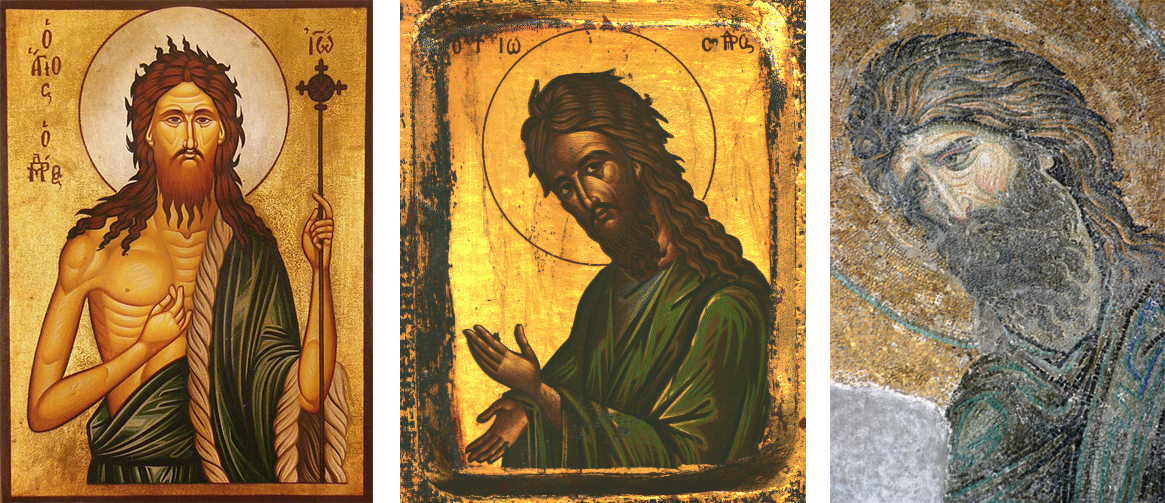 I have also seen images that have been mistaken for Jesus and Mary which are ancient personifications of the sun and moon, with the circle around the figure’s head being assumed to be a halo rather than the sun symbol.
I have also seen images that have been mistaken for Jesus and Mary which are ancient personifications of the sun and moon, with the circle around the figure’s head being assumed to be a halo rather than the sun symbol.
More Undulating Shapes
Coming back to the original manuscript, there are some other interesting illustrations. Often there are odd, round formless wiggly shapes in medieval manuscripts that are hard to interpret. For example, if this were drawn without an image of God next to it, it might be hard to recognize it as a picture of “the waters” being gathered into one place:
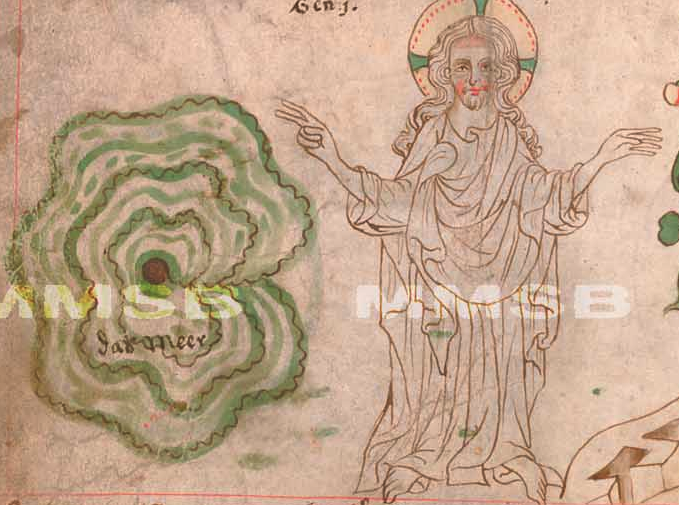 In the following panel, there is something vaguely cloud-bandish lined with stars. To the sides, are personifications of the dark and the light (the moon and the sun). In this case, the scalloped lines and stars represent “the expanse of the heavens” to separate the night from the day:
In the following panel, there is something vaguely cloud-bandish lined with stars. To the sides, are personifications of the dark and the light (the moon and the sun). In this case, the scalloped lines and stars represent “the expanse of the heavens” to separate the night from the day:
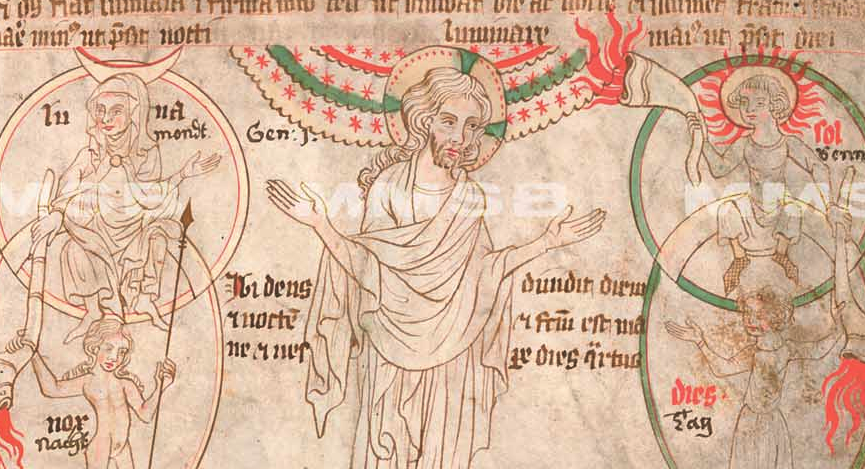 You’ll notice there are flame-like lines emanating from a number of horns. I believe these are meant to represent light (which in medieval times was usually provided by torches and oil lamps).
You’ll notice there are flame-like lines emanating from a number of horns. I believe these are meant to represent light (which in medieval times was usually provided by torches and oil lamps).
The next panel has undulating green lines to separate land from water. It depicts birds above and “swarms”of living creatures and great sea monsters below, with the lines painted right over the aquatic creatures (this was a very common way to draw water in the Middle Ages):
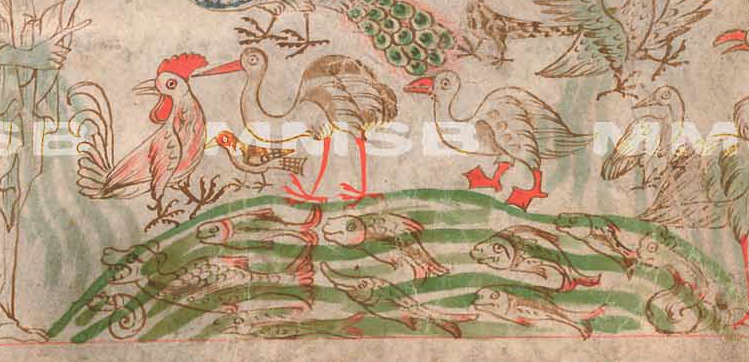 The palette in these illustrations caught my attention because it is very similar to the VMS. The brown is probably gall ink, and most of the water is a common shade of green. Blue is used more sparingly for highlights. The main difference is the shade of red, which is quite unusual, almost a fluorescent color. Older manuscripts with this palette tended to use orange rather than red, especially those copied in the Roman style. Later ones tended toward a true red, so perhaps this is a blend of orange and red pigments with egg binder that brightens up the color (I don’t know if this manuscript has been chemically analyzed, so this is pure guesswork).
The palette in these illustrations caught my attention because it is very similar to the VMS. The brown is probably gall ink, and most of the water is a common shade of green. Blue is used more sparingly for highlights. The main difference is the shade of red, which is quite unusual, almost a fluorescent color. Older manuscripts with this palette tended to use orange rather than red, especially those copied in the Roman style. Later ones tended toward a true red, so perhaps this is a blend of orange and red pigments with egg binder that brightens up the color (I don’t know if this manuscript has been chemically analyzed, so this is pure guesswork).
Next, after the terrestrial creatures are created, we see an interesting scene with a water theme common to older biblical illustrations, but less common in later centuries. Around a drawing of newly created man are four women, naked from the waist up, holding jugs of flowing liquid. If you follow the biblical narrative, you might expect mists steaming up from the earth rather than water flowing downward, but this is inspired by a later passage in which a river flows out of Eden to water the garden, from which it divides to become four rivers.
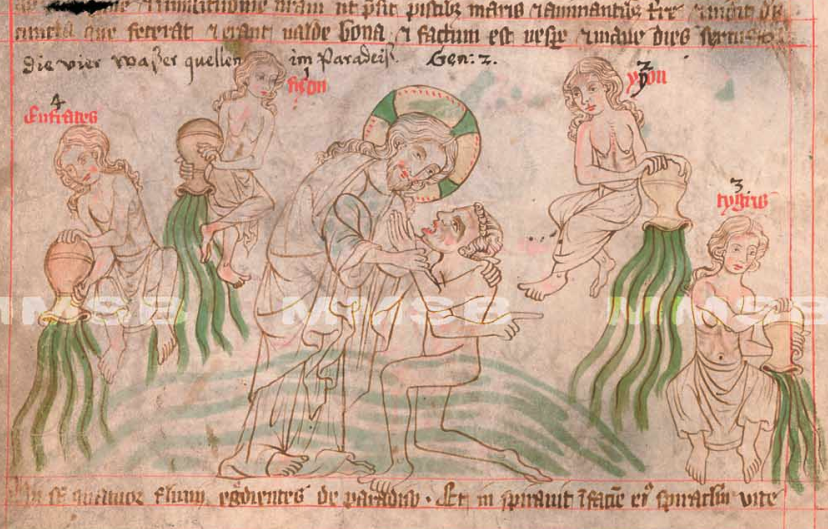 The composition borrows from traditional pagan styles, with nymphs dispensing the water, as was widely believed before Christianity, and are echoed in Homer’s Odyssey, in which the four fountains on the island of Ogygia, home of the nymph Calypso (daughter of Atlas) were described as, “…fountains four in a row… flowing with bright water hard by one another, turned one this way, one that.”
The composition borrows from traditional pagan styles, with nymphs dispensing the water, as was widely believed before Christianity, and are echoed in Homer’s Odyssey, in which the four fountains on the island of Ogygia, home of the nymph Calypso (daughter of Atlas) were described as, “…fountains four in a row… flowing with bright water hard by one another, turned one this way, one that.”
We know these represent the sources of four rivers because they are explicitly labeled Eufrates (Euphrates), fizon (Pishon), ygon (Gyon/Gihon), and tygris (Tigris) after the four rivers mentioned in Genesis. The Tigris and Euphrates flow through the Fertile Crescent, also known as “the cradle of civilization”, an apt reference to the Garden of Eden. Historians are not certain which rivers represent the Pishon or Gihon (there are many theories) or whether they still exist.
This 6th-century Libyan mosaic of the Pishon river is thematically similar to the illustration above, with a nymph at the head of the stream and an inverted jug dispensing the water. The same mosaic depicts other rivers of paradise, including the Tigris (shown right). For Voynich researchers following the “crown grotto” thread on voynich.ninja, note that the course of the Pishon (perhaps coincidentally) is drawn in spirals like a curl of hair:
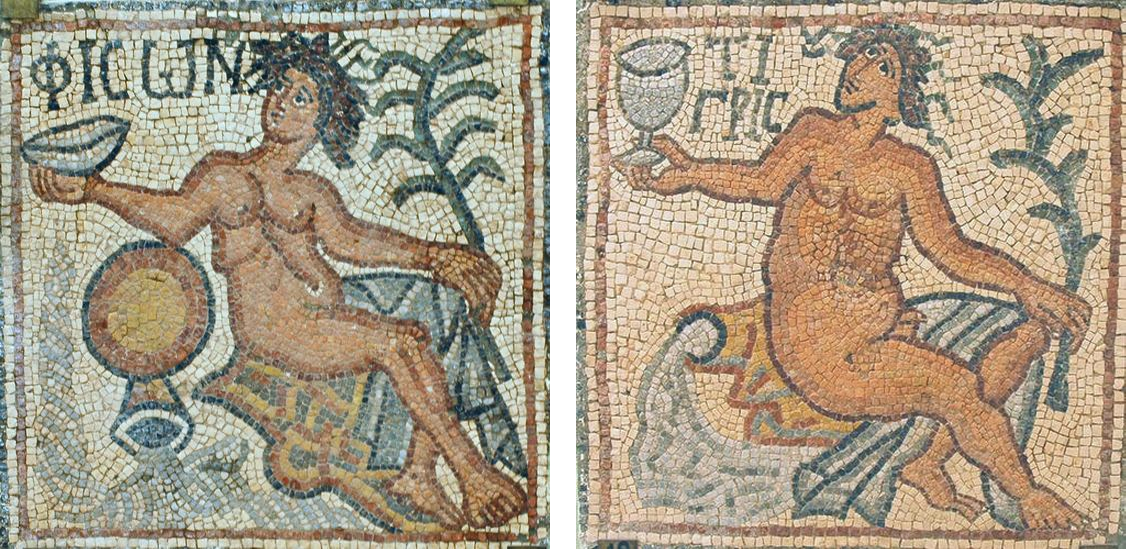 A few panels later, after Adam and Eve bear sons, we see a more classic depiction of a deeply infurled cloudband. On the left, the hand of God is reaching out to Abel. This style was still in vogue when the printing press was invented two centuries later and was used in woodblock prints (right).
A few panels later, after Adam and Eve bear sons, we see a more classic depiction of a deeply infurled cloudband. On the left, the hand of God is reaching out to Abel. This style was still in vogue when the printing press was invented two centuries later and was used in woodblock prints (right).
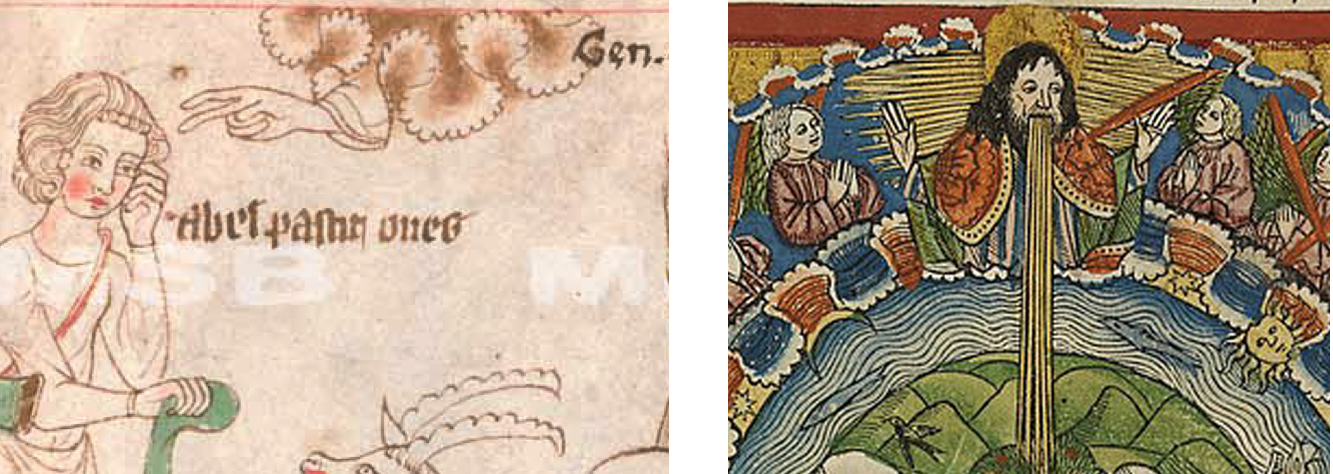 In the story of Noah’s ark, we see water depicted in a different way, as overlapping concentric curves, probably to emphasize the waves and vastness of The Flood. Under the waves are the outlines of the drowned:
In the story of Noah’s ark, we see water depicted in a different way, as overlapping concentric curves, probably to emphasize the waves and vastness of The Flood. Under the waves are the outlines of the drowned:
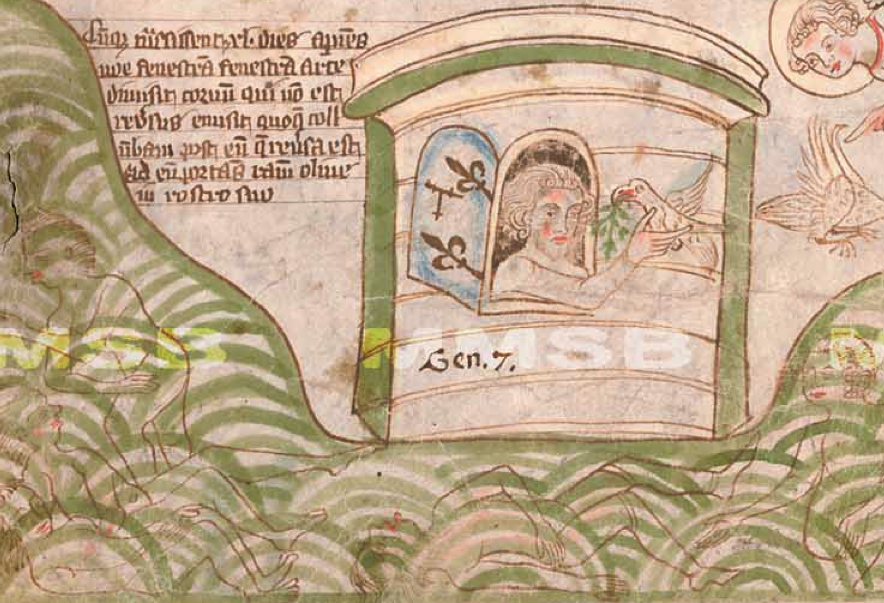 In a subsequent panel illustrating the construction of the tower of Babel, which was ambitiously designed to reach into heaven, God comes down and and thwarts the effort by dividing the languages of the workers so they can no longer easily cooperate. There are three cloudbands, one unpainted, one blue, the other a double band painted green, each with a hand and a staff to harass the workers. The differences between them appear quite deliberate so it might be intended to illustrate different points in time or the activities of God’s helpers:
In a subsequent panel illustrating the construction of the tower of Babel, which was ambitiously designed to reach into heaven, God comes down and and thwarts the effort by dividing the languages of the workers so they can no longer easily cooperate. There are three cloudbands, one unpainted, one blue, the other a double band painted green, each with a hand and a staff to harass the workers. The differences between them appear quite deliberate so it might be intended to illustrate different points in time or the activities of God’s helpers:
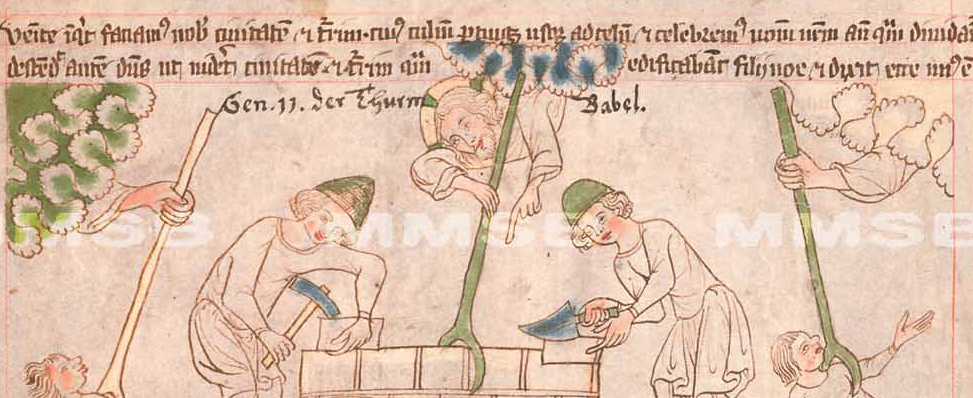 Thus, humanity is scattered across the earth and many panels of war and mayhem follow.
Thus, humanity is scattered across the earth and many panels of war and mayhem follow.
As far as celestial imagery goes, the illustrator hasn’t run out of ideas yet.
Further on, we see new forms of heavenly bands in the panels where God promises to shield and reward Abraham and Abraham, in turn, beseeches God for a son. In the first, a figure is poking out from a cloud-shape created with spiral forms reminiscent of the curlicues the Persians inherited from Chinese art. In the second, a finely scalloped edge encloses red stars against a blue background. This is not just a decorative element, but part of the story—Abraham is tasked with counting the stars and if he can, his descendants will number the same:
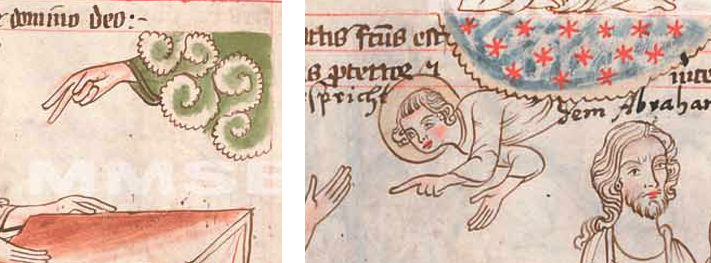 Most of the subsequent drawings of water and cloudbands follow the same basic styles as illustrated above, but there are other illustrative conventions of interest in this manuscript…
Most of the subsequent drawings of water and cloudbands follow the same basic styles as illustrated above, but there are other illustrative conventions of interest in this manuscript…
In the following panel, there are overlapping round shapes in the folds of the men’s tunics. This is a common way to depict coins in various forms of manuscripts, including chronicles, Bibles, and books of law. Abraham has asked Ephron to sell him a piece of a field and caves to bury his dead, so the coins represent shekels, and Sarah is shrouded in a box to the right, awaiting completion of the transaction so she can be buried. Note the jagged scallops under the box. When drawn and colored this way, they usually represent chasms, ditches, and holes in the ground.
Sorting Myth from Reality
Sometimes there’s no way to know if an image is literal or allegorical unless you know the story behind it.
In the following drawing, a woman with face and hair similar to the river-nymphs holds a jug upside down, with liquid streaming from it. In the previous pictures, the stream represented a river and the women were mythical nymphs that protected and dispensed the water. In this drawing, however, the interpretation is more literal. The camels were led to a well in the city of Nahor where women drew water in the evenings. The damsel is not a nymph, but a woman named Rebekah. The main difference between her and the drawings of the nymphs is that she is fully clothed:
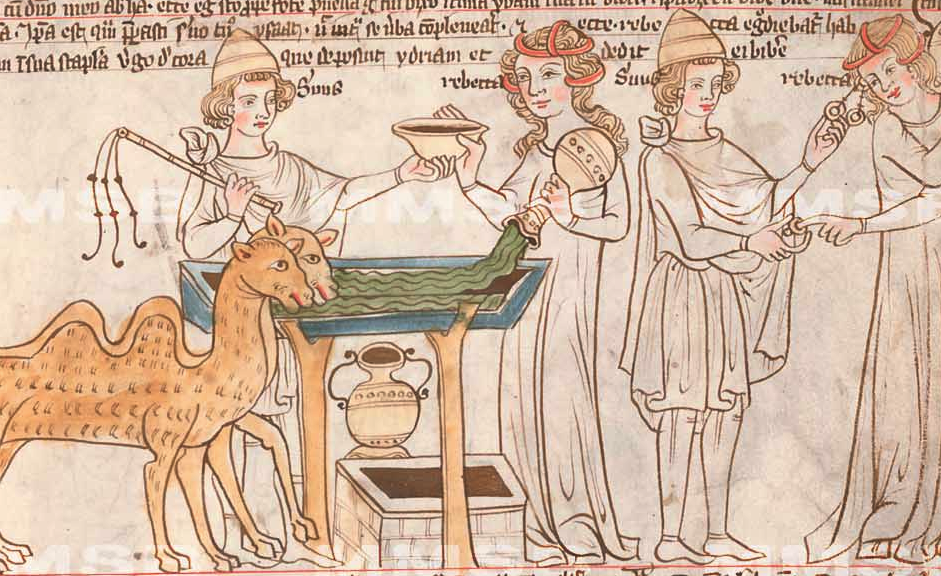 Rebekah shows a kindness by offering water to the traveler and his camels. The two figures to the right are the same people after the camels have been watered, which might be confusing because it’s in the same panel and could be mistaken for two other people at the well.
Rebekah shows a kindness by offering water to the traveler and his camels. The two figures to the right are the same people after the camels have been watered, which might be confusing because it’s in the same panel and could be mistaken for two other people at the well.
The “panel” to the right illustrates the emissary giving Rebekah a ring—it could be a nose ring, finger ring, or earring (historians and theologicans aren’t sure which kind of ring is meant), along with two bracelets of gold—a rather excessive payment for a few gallons of water, but it was more of a bribe and expression of intent, since he was tasked with finding and bringing back a bride. [As an aside, it’s hard to believe Rebekah, who was from a well-to-do family, would be drawing water (normally a servant would do it), but since divine intervention is at work here, we’ll let it pass.]
Summary
Many of the shapes in this manuscript would be difficult to interpret if it didn’t have a well-known backstory, so it’s refreshing to find such a variety of water and cloud/celestial imagery in a text that’s easy to read. Earlier medieval texts were sometimes abbreviated almost as much as the later ones, but the handwriting in the earlier periods was generally more clear than Gothic styles that came later.
Note that many themes of water, rivers, ponds, drowning animals, and rings are also found in the VMS. These are elements common to many legends, both biblical and otherwise.
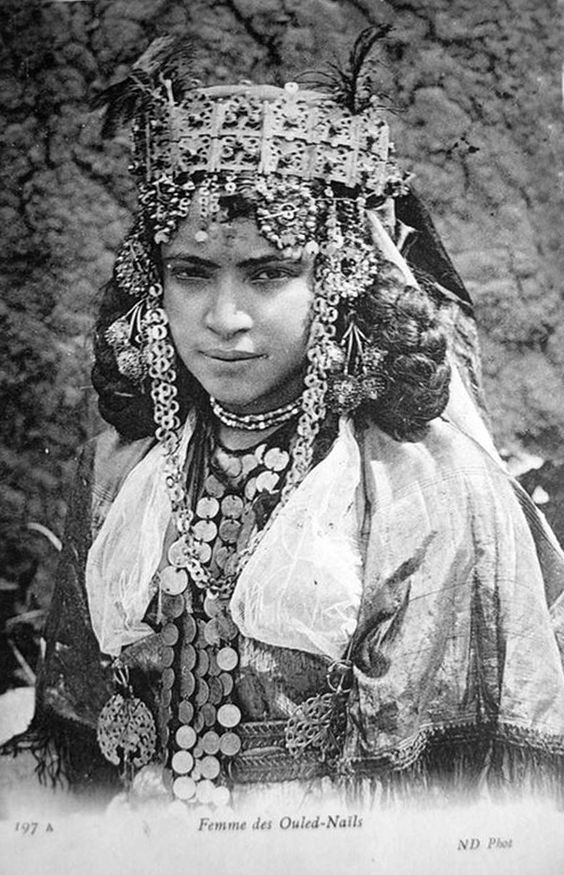 One of the things the drawing of Rebekah brought to mind that I find interesting about ancient cultures, is that women paraded the family’s wealth. They walked around wearing a significant portion of family gold and jewels, dangling from their waists, ears, foreheads, arms, and ankles. If you tried to do that in New York or London or any major city today, you’re asking to be dismembered.
One of the things the drawing of Rebekah brought to mind that I find interesting about ancient cultures, is that women paraded the family’s wealth. They walked around wearing a significant portion of family gold and jewels, dangling from their waists, ears, foreheads, arms, and ankles. If you tried to do that in New York or London or any major city today, you’re asking to be dismembered.
This custom, in turn, reminded me of the mysterious ring-like shapes in the VMS. Usually rings in manuscripts represent marriage or sometimes mirrors. In some cases they represent coronation. But perhaps there’s a further possibility, that of representing a transaction, or intent to bargain, with the ring as a down payment until the final terms are settled.
J.K. Petersen
© 2017 J.K. Petersen, All Rights Reserved

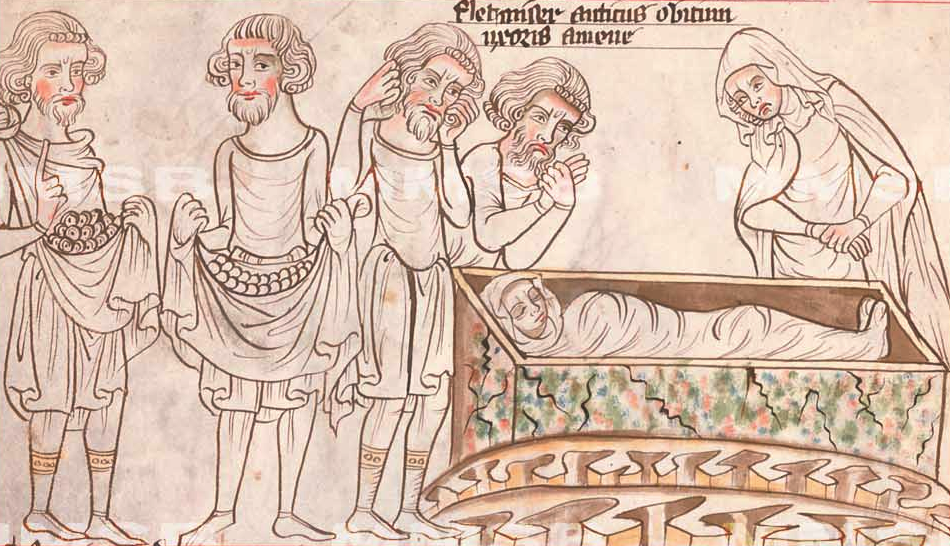
The clouds have parted and the waters as well.
I certainly agree with your statement ” many examples of imagery being misinterpreted because modern viewers are unaware of old traditions.”
Heraldry seems to be a valid tradition of the Middle Ages and the examples shown for heraldic lines of division can provide useful definitions for patterns found in various cloud band designs. Nebuly lines are found in various cosmic illustrations, while wavy lines are more often used as a way to represent water. However, there can be some crossover with wavy lines found in the occasional celestial diagram, so there is reason to cautious . The works of Christine de Pizan show fancy, scallop-shell patterns, based on the general form of a nebuly line, in the ‘Queen’s Book’ and the use wavy lines in the ‘Knight’s Book.’ And there are a number of other patterns that have been used in cloud band illustrations as you have shown here and even more examples are in the collective effort developed in Voynich.ninja discussions.
Modern misinterpretations would certainly seem to have occurred in Newbold’s interpretation of VMs f68v as a Roger Bacon illustration of a telescopic sighting of the Andromeda Galaxy. Would that interpretation still be considered, if the Oresme depiction of the cosmos had been known to those investigators?
Modern investigators, unaware of old traditions, will have problems not only with misinterpretation, but they may fail to recognize the presence of traditional information altogether.
JKP
Three questions:
1. You have all the medieval manuscript images from [MS] České republiky XXIII.C.124 – is that right?
2. When was it made? What sort of text is it – I mean, an illustrated Bible, or …?
3 Is the catalogue entry accessible? For details of material, place of manufacture and page size etc.
Nice example – the colour range is the most basic and the faces have roses in their cheeks.
Sorry JK – I should have looked online for myself.
To save you the trouble … I add for any others who might want details:
The MS is
Velislavova bible (Biblia picta Velislai) (c.1340).
Online link
http://v2.manuscriptorium.com/apps/main/en/index.php?request=show_tei_digidoc&docId=set03112148&client=
I’d add that ‘Manuscriptorium’ is a very good way to start study of medieval mss.
http://www.manuscriptorium.com/
Thank you for posting the link. I had intended to link the name at the top but got called away and never got back to it.